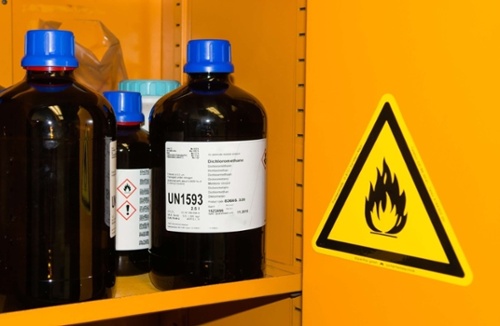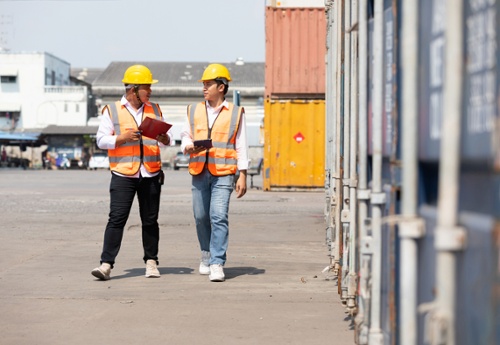When you use, store, or handle any type of hazardous chemicals on the job site you have a legal responsibility to ensure those chemicals are correctly labeled. Hazardous chemicals must be easy to identify, so staff are immediately alerted to the health and safety risks that the hazardous substances pose. This post outlines the essential steps that you can take to ensure you’re labeling and storing hazardous chemicals in the right way.
THINGS TO CONSIDER: Do you have procedures in place if a chemical label fell off a package of hazardous chemicals? How about when you decant fuel or cleaning products into portable containers? What do you do about containers that are too small for a label?
STEP 1: Chemical Labels in the Workplace
Before you can make sure a chemical is properly labeled, you need to know the requirements of the WHS Regulations. In Australia, labels on hazardous chemicals must be written in English with specific details to be included.
So, what should be included in the label and package of chemicals?
Your chemical labels must include the following:
- Product identifier
- Contact details of the manufacturer or importer
- Breakdown of the ingredients with percentages/ratios
- Hazard Pictogram
- Hazard Statement, Signal Word, Precautionary Statements
- First aid treatment and emergency procedures if not already included in the precautionary statements
- Expiry date (if applicable)
You’ll also need chemical labels and signs for any hazardous substances that are:
- Manufactured in your workplace (including research samples created in the lab)
- Transferred or decanted from the original container
- Held in a pipeline

Regardless of how small or big your container is, it needs to be properly labeled to illustrate the hazards associated with the chemical product.
Decanted or Transferred Hazardous Chemicals
If you decant or transfer hazardous substances out of their original container, you have a responsibility to ensure that the secondary or portable container features the correct chemical labels.
Many workplace accidents have occurred when staff have decanted cleaning chemicals into soft drink bottles or plastic cups — then mistakenly consumed by a co-worker or customer.
As a minimum, the secondary container holding a decanted chemical must display both:
- The product name/identifier; and
- A pictogram or hazard statement that identifies the hazard class of the chemical.
NOTE: The decanted hazardous chemicals do not require labeling if the entire amount is immediately used by the person who decanted it. However, it must only be used by that person and the chemical container must never be left unattended. When transferring hazardous substances, make sure that the container is cleaned thoroughly before use. Even the smallest traces of hazardous chemicals in seemingly ‘empty containers’ can lead to a hazard.
Small Containers
Sometimes, chemicals are stored or transferred into containers or ampoules which are so small that a label won’t fit. However, keep in mind that even the tinniest of containers still require the same amount of information as any other hazardous chemical container.
You may choose to keep very small ampoules in a box, attaching the label to the outside of the box or keeping a leaflet inside. Swing tags can also be attached to some small containers.
REMEMBER: The Code of Practice (by Safe Work Australia) for the Labelling of Workplace Hazardous Chemicals displays label templates for small containers.
Additional Chemical Labeling Requirements
In addition to the chemical labelling requirements, there are also further chemical labeling requirements for hazardous substances.
These chemical labeling requirements include:
- Waste products - if it is reasonably likely that a waste product is a hazardous substance, then it must be labeled with as much information as possible including pictogram, hazard class and precautionary statements.
- Pipework – pipework for hazardous chemicals must be colour-coded, with compliant signs and placards erected nearby. The pipework must be clearly marked on schematic drawings or site plans.
- Research chemicals – chemicals created in the lab for analysis must be labeled with as much information as possible including the chemical properties, ingredient mix and likely hazards.
REMEMBER: When dealing with complex chemical mixtures, such as in a laboratory setting, the identity of all hazardous substances must be determined so far as it’s reasonably practicable to do so. Ingredient and formulation information for these hazardous substance mixtures must include chemical families or sub-families, where possible.
STEP 2: Receiving Hazardous Chemicals
Having an excellent relationship with your suppliers, as well as understanding your supply chain, is a critical aspect of chemical safety.
Once you’re fully conversant with chemical labeling requirements, you should train your staff to only accept chemical deliveries if they have the correct label and Safety Data Sheet.
TIP: Apart from incorrectly labeled chemicals, don’t accept deliveries of chemical packages that are damaged or have broken seals. Reject gas bottles with worn label plates or outside their test date.
STEP 3: Storing Chemicals Safely
When they aren’t being used, it’s very important to ensure that your labeled chemicals are stored in a safe and efficient manner.
Being storage experts, the team here at STOREMASTA have a few quick recommendations:
- Create dedicated chemical stores for different hazard classes using purpose-built safety cabinets. For example: cabinets for compressed gases, corrosives, and detonators arrive with the correct placards, labels and signs.
- Have convenient under-bench cabinets available for smaller quantities of lab chemicals like acid. This dissuades staff from leaving chemicals on the floor, bench tops, window ledges, or balconies.
- Keep flammable liquids, corrosives and toxic chemicals in dedicated cabinets that are fitted with perforated shelving and a liquid-tight spill sump.
- Have correctly labeled spill kits on hand and train staff how to use them.
- Keep hard copies of Safety Data Sheets attached to chemical cabinets in a robust document box. Again, properly marked and labeled
One of the best ways to minimise risk when carrying hazardous chemicals, is to have consistent housekeeping practices. These practices will include such tasks as keeping packages stacked neatly, wiping down containers after use to remove residue, and ensuring that no chemicals are being stored in the spill sump of your indoor safety cabinet.
Housekeeping and maintenance of your chemical storage areas is not just a good idea, it’s a requirement under Australian WHS laws.
It’s also crucial to train your staff to put chemical containers away when they aren’t being used. If containers are left lying around a worksite, there is a high likelihood that a hazard will occur due to the lack of protection for the hazardous substance. Make sure your staff are trained to understand how to use their storage equipment, as well as the hazards that are being controlled when the chemicals are stored correctly.
STEP 4: Site Audits and Corrective Actions
Once you have everything in place, conduct regular site audits that note incorrect labels and missing placards.
Take corrective action after every audit, and make sure those labels are placed on the appropriate containers and all missing or damaged placards are replaced.

Regular inspections at your workplace will help you ensure that labels and storage procedures are being upheld by staff members.
Why is it Important to Label Chemicals in the Workplace?
Checking your chemical stores for correct container labeling and safety compliance auditing is an essential part of chemical risk management. It’s also an essential part of maintaining health and safety in your workplace. To learn more about how to fully comply with WHS Regulations and chemical safety standards through the implementation and maintenance of safe storage, why not access our eBook? The Ultimate DG Storage Handbook will walk you through all the important questions you’ll need to ask if you’re storing hazardous chemicals and dangerous goods in your workplace.
Joining the team as a Dangerous Goods Storage Consultant, Melissa Hampton became Storemasta's Marketing Manager in late 2021. With extensive knowledge and experience in chemical compliance, Melissa is responsible for leading the Marketing team and helping shape their marketing strategy. In her spare time, you can find Melissa hiking, swimming and enjoying the great outdoors in beautiful north-west Tasmania.

